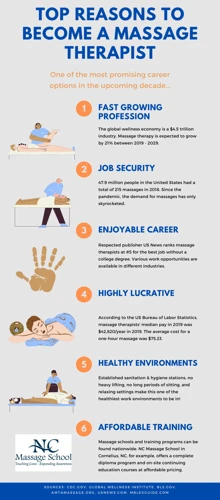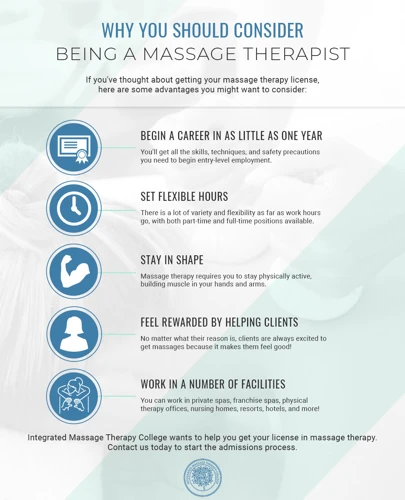Are you interested in learning how to start a career in massage therapy? If so, you’ve come to the right place! Massage therapy is a career that requires both physical and mental skill — but one that can be extremely rewarding. In this comprehensive guide, you’ll learn everything you need to know to launch a successful massage therapy career. We’ll cover topics such as the different types of massage therapy, the education and licensing requirements, and the steps to take to get started. With this guide in hand, you’ll be ready to begin your journey as a massage therapist.
Contents
Benefits of a Career in Massage Therapy

Massage therapy is a rewarding career that offers many benefits. It can provide financial stability and job security, as well as the potential to earn a high salary. Additionally, massage therapists can work flexible hours, choose their own clients, and enjoy a creative, hands-on career. Massage therapy also offers the opportunity to help people in need, reduce stress, and improve quality of life.
Those who wish to work as massage therapists must complete a training program to earn a professional certification. After obtaining their license, they can begin to look for jobs in salons, spas, medical facilities, resorts, and other settings. Qualified massage therapists may also be able to set up their own massage practice.
In addition to the professional rewards, massage therapists enjoy the physical benefits of their work. Massage therapy can help reduce stress and muscle tension, improve circulation, and promote relaxation. It can also reduce back pain, tension headaches, and other physical ailments.
Finally, the personal satisfaction that comes from helping people is one of the most rewarding aspects of massage therapy. Massage therapists are able to use their training and knowledge to improve the lives of their clients. With the right training and certification, massage therapists can make a positive difference in the lives of others and get a job in massage therapy.
Education and Training Requirements

- High school diploma or equivalent is required for many massage therapy programs.
- Massage therapy certification from an accredited program is necessary for licensure.
- Continuing education is required for renewing massage therapy licensure.
- A background check may be required for some massage therapy programs.
Certification and Licensing Requirements

In order to become a massage therapist, you need to obtain certification and licensing. In most states, certification is required by law. The requirements for certification and licensing vary by state, so it is important to research the specific requirements in your state of residence. In general, the following requirements must be met:
Education: You must complete a massage therapy program from an accredited institution and pass the National Certification Board for Therapeutic Massage & Bodywork (NCBTMB) exam.
Experience: You must have at least 500 hours of supervised, hands-on massage therapy experience.
License: You must apply for and obtain a state license to practice massage therapy, which may require a background check and/or a state exam.
Continuing Education: Most states require continuing education in order to renew a license.
| State | Certification Requirement | License Requirement |
|---|---|---|
| Alabama | NCBTMB Exam | State Exam |
| California | NCBTMB Exam | Background Check |
| New York | NCBTMB Exam | State Exam |
| Texas | NCBTMB Exam | Background Check |
Job Opportunities for Massage Therapists
| Industry | Employment |
|---|---|
| Healthcare and Social Assistance | 58% |
| Personal Care Services | 20% |
| Educational Services | 8% |
| Sports and Recreation Industries | 5% |
| Amusement, Gambling and Recreation Industries | 3% |
| Other | 6% |
Massage therapists are in demand and the job opportunities are growing. The majority of massage therapists are employed in the healthcare and social assistance industry, where they make up 58% of the massage therapy workforce. Personal care services are the second-largest employer of massage therapists at 20%. Educational services, sports and recreation industries, and amusement, gambling, and recreation industries each employ 8%, 5%, and 3% of massage therapists, respectively. The remaining 6% are employed in other industries.
Additionally, massage therapists often find employment in spas, resorts, and other establishments that offer wellness services. These establishments may provide part-time, full-time, or contract positions. Self-employment is also an option for massage therapists who have the necessary resources and skills.
Setting Up Your Massage Therapy Practice

1. Get Licensed and Insured
- Obtain a massage therapy license and liability insurance.
- Check with your state board to ensure that you meet the necessary requirements.
- Purchase a liability insurance policy to protect your business and yourself.
2. Establish Your Business Structure
- Choose a business structure, such as sole proprietorship, partnership, or LLC.
- Find a business name that is not already taken.
- Register your business with the state and obtain any necessary licenses or permits.
- Open a business bank account and obtain an Employer Identification Number (EIN).
3. Find Office Space
- Research the area to find a location suitable for your massage therapy practice.
- Choose a space that is accessible and appealing to your clients.
- Sign a lease or purchase the property.
- Set up the office with necessary furniture, equipment, and supplies.
4. Establish Your Pricing Structure
- Determine the services you will offer and their associated costs.
- Develop a pricing structure that is fair to both you and your clients.
- Set up payment options, such as cash, check, or credit cards.
5. Market Your Business
- Create a website and social media accounts.
- Develop a marketing plan to promote your business.
- Network with other professionals in the massage therapy field.
- Advertise your business in local publications.
Professional Associations for Massage Therapists

Professional associations are an important resource for massage therapists. These organizations provide support, professional development, and advocacy for massage therapists. They also provide resources and information on best practices and industry standards.
American Massage Therapy Association (AMTA): The AMTA is the largest professional association for massage therapists in the United States. It is dedicated to advancing the massage therapy profession through research, education, and leadership. The AMTA provides resources such as continuing education courses, professional development, and public awareness campaigns.
Associated Bodywork & Massage Professionals (ABMP): ABMP is the largest massage therapy association in the United States, representing over 25,000 members. It provides resources on a variety of topics, including professional development, professional ethics, and legislative advocacy.
World Massage Therapist Association (WMTA): The WMTA is a global association for massage therapists. It provides resources for massage therapists, including a directory of massage therapists, continuing education courses, and a job search tool.
International Massage Association (IMA): The IMA is a global network of massage therapists and massage therapy organizations. It provides resources for massage therapists, including continuing education courses, professional development, and advocacy.
| Organization | Location | Resources |
|---|---|---|
| American Massage Therapy Association (AMTA) | United States | Continuing education courses, professional development, public awareness campaigns |
| Associated Bodywork & Massage Professionals (ABMP) | United States | Professional development, professional ethics, legislative advocacy |
| World Massage Therapist Association (WMTA) | Global | Directory of massage therapists, continuing education courses, job search tool |
| International Massage Association (IMA) | Global | Continuing education courses, professional development, advocacy |
Marketing Your Massage Therapy Practice
- Create a website for your massage therapy practice and make sure it is easily found on search engines. Incorporate SEO best practices to optimize your website for search engine visibility.
- Register your massage therapy practice on local business directories and review sites like Yelp, Google+, and Facebook.
- Create a newsletter or email campaign to keep in touch with your existing and potential clients.
- Advertise your services in local newspapers, radio, and television.
- Network with other massage therapists in your local area.
- Develop a good relationship with local physicians and health practitioners to generate referrals.
- Create special offers and discounts to attract new clients.
- Participate in local events and health fairs to promote your services.
- Make use of social media platforms like Facebook, Twitter, and Instagram to build relationships with your clients.
- Create brochures, business cards, and flyers to promote your services.
Financial Considerations for Massage Therapists
Start-up Costs: Starting a massage therapy business can be expensive. A massage therapist will need to purchase supplies such as a massage table, towels, and lotions. Other costs may include training, licensing, and insurance.
Self-Employment: Massage therapists often work as independent contractors, meaning they are self-employed. This means that they are responsible for their own taxes and they must pay their own overhead costs.
Income: Massage therapists have the potential to earn a good income, but their income will depend on the number of clients they have and the services they offer. Many massage therapists charge per session, while others may charge a flat fee for a package of services.
Flexibility: Massage therapists often have the flexibility to set their own hours and choose their own clients. This allows them to create a schedule that works for their lifestyle.
Taxes: Massage therapists must pay taxes on their income. Self-employed massage therapists are responsible for paying self-employment taxes, which include Social Security and Medicare taxes.
Benefits: Massage therapists often have the flexibility to work in a variety of settings, including spas, clinics, and private homes. Many massage therapists also have the option to set their own rates.
Frequently Asked Questions
What Qualifications are Needed to Become a Massage Therapist?
To become a massage therapist, individuals must obtain a state-approved massage therapy license or certification. Requirements vary by state and may include completion of an approved massage therapy course, passing an exam, and in some cases, providing proof of liability insurance. Most states require massage therapists to have at least 500 hours of education and training. Additionally, massage therapists may need to obtain specialized certifications or continuing education in order to practice certain types of massage.
What is the job outlook for massage therapy?
Job Growth: According to the Bureau of Labor Statistics, the job outlook for massage therapists is expected to grow by 22% between 2018-2028, much faster than the average for all occupations.
Demand: The demand for massage therapy is strong and growing due to increasing awareness of the health benefits of massage and the need for alternative therapies for pain relief and stress management.
Employment Opportunities: Massage therapy is a versatile career and there are many potential employment opportunities. Massage therapists may work in spas, salons, private practices, medical offices, sports teams, or corporate settings.
Compensation: The median annual wage for massage therapists was $41,420 in May 2019. Earnings vary depending on location and experience.
Opportunities for Advancement: As a massage therapist gains experience, they may pursue additional certifications or specialize in a particular area. This may lead to higher pay, more responsibility, and more opportunities.
What type of experience and training is required?
Massage therapists must complete a professional training program that typically consists of 500–1,000 hours of study and experience. This includes a combination of classroom instruction and hands-on experience. Training also includes anatomy and physiology, massage techniques, client assessment, and business and ethics education. Depending on the state, massage therapists may need to be licensed or certified. Licensing requirements vary by state, with some states having additional requirements such as a criminal background check.
How Much Do Massage Therapists Typically Earn?
Massage therapists typically earn anywhere from $30,000 to $60,000 annually, depending on the location, experience, and type of practice. Some massage therapists also work as independent contractors and earn an hourly rate. Those who work for spas and resorts may also receive tips from clients. Massage therapists may also receive bonuses, commissions, and health care benefits.
What Types of Massage Therapy Certifications are Available?
Massage therapists are required to obtain a certification to practice professionally. Depending on the state, different certifications may be required. The most widely recognized massage therapy certifications are:
- National Certification Board for Therapeutic Massage and Bodywork (NCBTMB): This certification is accepted in all 50 states, the District of Columbia and Puerto Rico. It is designed to assess a massage therapist’s knowledge, skills and abilities in providing therapeutic massage and bodywork services.
- American Massage Therapy Association (AMTA): This is the most widely recognized massage therapy certification. It is recognized in all 50 states, the District of Columbia and Puerto Rico. This certification is designed to assess a massage therapist’s knowledge, skills and abilities in providing therapeutic massage and bodywork services.
- American Massage Therapy Association Certified Massage Therapist (AMTA-CMT): This is a more advanced certification that requires a minimum of 500 hours of supervised experience in therapeutic massage and bodywork. To be eligible for certification, the applicant must have completed a massage therapy program that meets minimum educational standards.
- National Certification Examination for Therapeutic Massage and Bodywork (NCETMB): This certification is accepted in all 50 states and the District of Columbia. This examination is designed to assess a massage therapist’s knowledge, skills and abilities in providing therapeutic massage and bodywork services.
- Certified Massage Therapist (CMT): This certification is accepted in all 50 states and the District of Columbia. It is designed to assess a massage therapist’s knowledge, skills and abilities in providing therapeutic massage and bodywork services.
The certifications listed above are the most commonly recognized certifications for massage therapists. However, some states may require additional certifications. It is important to check with the specific state board of massage therapy to determine what certifications are required in order to practice massage therapy.
Conclusion
Massage therapy is a lucrative and rewarding career with many potential opportunities. It requires dedication and hard work, but with the right knowledge and resources, anyone can begin to build their career in massage therapy. Taking courses, obtaining certifications and licenses, and building a professional network of contacts are essential steps for those looking to enter this field. With the right preparation, massage therapy can be an enjoyable and successful career.
References
- U.S. Department of Labor: Apprenticeship Programs
- U.S. Department of Education: Massage Therapist Jobs
- American Massage Therapy Association: Starting a Career in Massage Therapy

